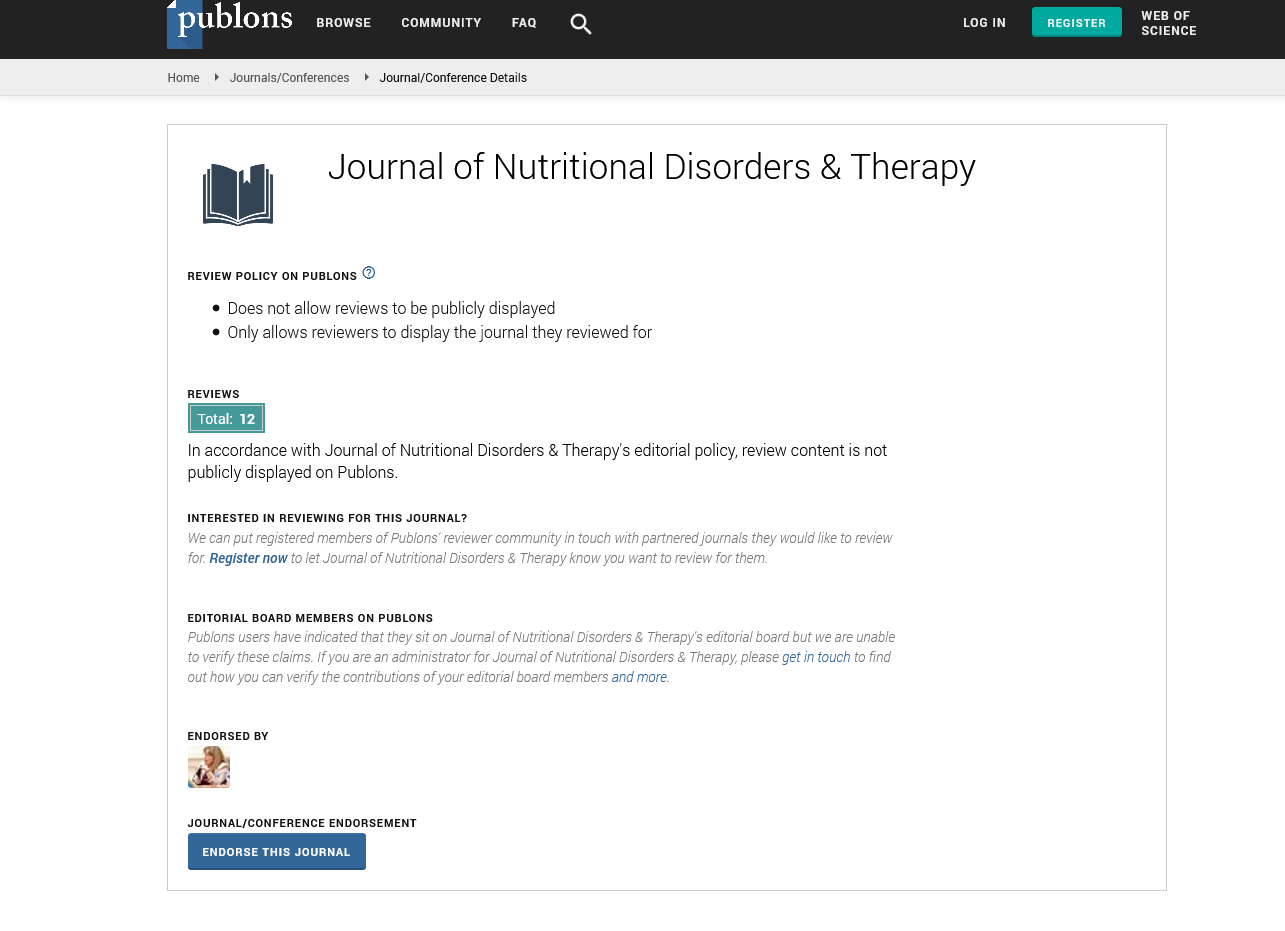Indexed In
- Open J Gate
- Genamics JournalSeek
- Academic Keys
- JournalTOCs
- Ulrich's Periodicals Directory
- RefSeek
- Hamdard University
- EBSCO A-Z
- OCLC- WorldCat
- Publons
- Geneva Foundation for Medical Education and Research
- Euro Pub
Useful Links
Share This Page
Journal Flyer

Open Access Journals
- Agri and Aquaculture
- Biochemistry
- Bioinformatics & Systems Biology
- Business & Management
- Chemistry
- Clinical Sciences
- Engineering
- Food & Nutrition
- General Science
- Genetics & Molecular Biology
- Immunology & Microbiology
- Medical Sciences
- Neuroscience & Psychology
- Nursing & Health Care
- Pharmaceutical Sciences
Commentary - (2025) Volume 15, Issue 2
Tissue Based Metabolic Patterns Linked to Lower Cachexia Rates in Cancer
Alexandra Ferreira*Received: 26-May-2025, Manuscript No. JNDT-25-29688 ; Editor assigned: 28-May-2025, Pre QC No. JNDT-25-29688 (PQ); Reviewed: 11-Jun-2025, QC No. JNDT-25-29688 ; Revised: 18-Jun-2025, Manuscript No. JNDT-25-29688 (R); Published: 25-Jun-2025, DOI: 10.35248/2161-0509.25.15.327
Description
Cancer cachexia is a multifactorial syndrome characterized by involuntary weight loss, muscle wasting and systemic inflammation. It affects a significant proportion of patients with advanced malignancies and contributes to reduced quality of life, limited treatment tolerance and shorter survival. Unlike starvation, cachexia does not respond fully to nutritional supplementation, making it a distinct metabolic condition. Recent interest has grown around the role of adipose tissue in the regulation of energy balance and metabolic function during illness. White adipose tissue is primarily responsible for energy storage, whereas Brown Adipose Tissue (BAT) plays a role in thermogenesis and energy expenditure. BAT activity has been previously associated with improved metabolic health in noncancer populations. However, its role in cancer-related weight changes and the onset of cachexia remains less understood.
This retrospective cohort study explores the association between the presence of metabolically active BAT and the progression of weight loss and cachexia in patients with solid tumors. By reviewing patient imaging and clinical records, we examined whether detectable BAT correlates with a lower incidence of cancer cachexia and reduced involuntary weight loss during the course of disease.
Brown adipose tissue
Brown adipose tissue differs functionally and structurally from white adipose tissue. It contains a high density of mitochondria and expresses Uncoupling Protein 1 (UCP1), which facilitates non-shivering thermogenesis. BAT is most abundant in infants, but functional depots persist into adulthood, primarily in the supraclavicular and paravertebral regions.
The metabolic activity of BAT is influenced by several factors, including cold exposure, hormonal regulation and systemic inflammation. In the context of cancer, systemic inflammation and altered energy metabolism are hallmarks of disease progression. While muscle atrophy has traditionally been a focus of cachexia research, the role of adipose tissue, particularly BAT, is gaining attention as an area of metabolic regulation that may influence disease outcomes.
The lower weight loss observed in BAT-positive patients may also reflect a more favorable baseline metabolic profile. While BAT activity is partly genetically determined, it can also be influenced by factors such as physical activity, nutritional status and ambient temperature exposure. Further studies are needed to determine whether BAT activation in cancer patients is modifiable and if interventions targeting BAT function can impact clinical outcomes.
Another important consideration is the interplay between systemic inflammation and adipose tissue activity. Chronic inflammation in cancer disrupts adipocyte function, contributes to lipolysis and impairs thermogenic responses. BAT’s anti-inflammatory properties may reduce cytokine-mediated catabolism, thereby mitigating tissue wasting. This hypothesis is supported by trends in our data showing lower CRP levels among BAT-positive individuals.
While muscle loss remains central to the diagnosis and pathophysiology of cachexia, the involvement of adipose tissue, particularly BAT, represents an additional factor influencing energy balance. Incorporating BAT assessment into clinical evaluations may improve risk stratification for cachexia and identify patients who could benefit from early nutritional and metabolic interventions.
Implications for clinical practice
Identifying patients at risk for cachexia is an essential component of supportive oncology care. The presence of BAT may serve as a marker of better metabolic resilience, allowing clinicians to anticipate which patients may experience less weight loss during treatment. It may also guide decisions regarding the timing and intensity of nutritional support, physical therapy, or pharmacologic interventions aimed at preserving body composition.
As cancer care moves toward more personalized approaches, understanding the role of tissue-specific metabolism will become increasingly important. BAT assessment could complement existing tools in evaluating nutritional status and designing supportive care strategies.
This retrospective cohort study demonstrates that the presence of brown adipose tissue is associated with reduced weight loss and a lower incidence of cancer cachexia in patients with solid tumors. These findings highlight the potential metabolic role of BAT in modulating the catabolic effects of cancer and suggest that BAT activity may serve as a useful clinical marker for cachexia risk. Further research is needed to determine whether BAT can be preserved or activated therapeutically in cancer patients as part of a comprehensive strategy to manage cancer-related wasting.
Citation: Ferreira A (2025). Tissue Based Metabolic Patterns Linked to Lower Cachexia Rates in Cancer. J Nutr Disord Ther. 15:327.
Copyright: © 2025 Ferreira A. This is an open-access article distributed under the terms of the Creative Commons Attribution License, which permits unrestricted use, distribution, and reproduction in any medium, provided the original author and source are credited.

